updated 2010 Jan 24

© www.witiger.com
| Internet
/ E-commerce Statistics
updated 2010 Jan 24 |

© www.witiger.com |
| INTRODUCTION | . | By
2009, statistical information about the growth of the Internet and e-commerce
has become a very large concern and there are thousands of sources. For
the purpose of our e-commerce class, we simply want some basic information
covering
see www.witiger.com/ecommerce/ecommercestatisticsOLDFILE.htm |
| SPEED of change | , | One of the most
important things to understand about statistics associated witht he internet,
internet use and internet marketing is the speed with which things change.
Some simple facts will explain this progression.
The number of internet devices
in 1984 was 1,000
- one thousand
What does this mean ? - what ever product or service you are thinking about selling now - will have statistics of use that cannot even be calculated in advance since the growth of use will incorporate variables you literally cannot imagine. How fast is information growing, it is estimated that a week's worth of reading the New York Times contains more information than a person was likely to come across in a lifetime in the 1800's. The amount of new technical information is said to be doubling every two years - for students starting a 4yr technical program and college or university, this means that half of what they learn in their first year will be outdated by 3rd year!!!! (NOTE: blogger Edward Luong posted in 2009 "Technology does not make equal progress on all fronts, and moreover, new fields are invented. And, how in the world do they even measure the amount of technical information produced in two years? "www.mrawde.com/blog/2009/04/do-the-numbers.html This is why you can't count on your profs and the course outlines for your education YOU HAVE TO read newspapers, blogs and listen to radio and TV news on a regular basis.Flexibility and adaptability will be key. WTGR |
| BIG PICTURE | , | It took the
This phrase is widely quoted on the Web from un.org to rcmp-grc.gc.ca, it is difficult to know where it came from, and it is difficult to know if it is the truth exactly - however a rough calculation makes it seem plausible that such a comparison is indeed valid. |
| / | , | Whether it is
50 million exactly, is not critical. What is noteworthy is the fact that
it is probably the fastest spread of any "technology" that the world has
ever seen, and there are consequences for that. One of the consequences
is that companies marketing global products and services must address a
whole new "sector" of business and do this very quickly - 'cause if they
don't, they will lose out to some other company that scoops them.
Essentially, the "picture" of the Information Age, as accelerated by the Internet, is one where the Competitive Environment is intensified, to a higher degree than before, by the advances in the Technological Environment. However, this increased usage
of the web has NOT translated into a proportionate explosion in commerce
on the web.
There are some web businesses (mostly "pure plays") that have gone from nothing to become gigantic businesses, but the average consumer products company has not gained huge sales from going online. |
| Total Number of Internet Users | 
www.internetworldstats.com/am/ca.htm |
| Total Number of Internet Users | In
2001-2003 when this unit was taught in our e-commerce class we used to
try to ascertain the total number of Internet Users and how that
number was growing.
In reality, this was a waste of time because the accuracy was difficult to verify (who can count them) and, you have to ask yourself "what did it mean?". Why did we need to know the total number of internet users? In terms of running an e-commerce business, knowing the total number of internet users is, by 2009, a useless statistic? Why? |
Total
Number of Internet Users
 |
Because,
... knowing the total number of internet users is information that would
only be useful to a small number of businesses, like IBM or Microsoft.
This is like telling a guy, who runs the Tim Horton's at Morningside and Sheppard, that there are 5 million Canadians who eat doughnuts regularly. That is nice to know, but useless information. "The possession of information is often considered a critical part of corporate competitiveness. Information itself is not so valuable - what is valuable is the tools to aggregate the information, manipulate it, synthesize it so you can draw conclusions which can assist in decisions" www.witiger.com/quotes.htmThe guy who runs the Tim Horton's at Morningside and Sheppard needs to know how many people, in the Morningside and Sheppard area eat doughnuts, and what kind. The purpose for explaining this Tim Horton's example is to help students understand that you can obtain stats on all kinds of things - but in many cases the information is not specific enough to be of true use to help you make a business decision. |
| Total Number of Internet Users | Counting
Internet users in 2009 is like counting people that use a phone.
By 2005, most every adult and teenager that wanted a cell phone, has one, they are so cheap now that cost is not a barrier. Same things with PCs - high quality computers with huge hard drives and super fast chips are less than $6,000 - (Netbooks are in the $300 range) there are many many companies selling PCs and the competitive environment has driven the prices way way down + there are many places at school, libraries, etc. where people can go online for free. There are very few barriers to internet access in OECD countries so most everybody who wants to be online, is online. |
| Total Number of Internet Users | 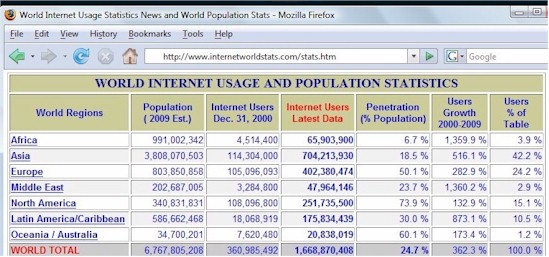
www.internetworldstats.com/stats.htm has the world total over 1.6 billion in mid-2009. |
| Total Number of Internet Users | Online, by
region 2009
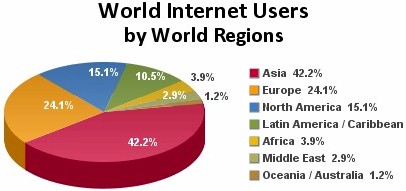
www.internetworldstats.com/stats.htm |
| Total Number of Internet Users | Online, by
language 2009
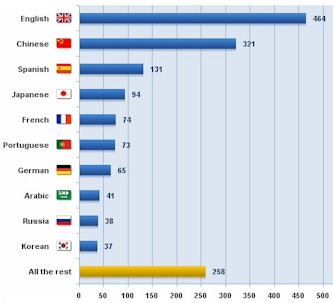
Online, by language 2004 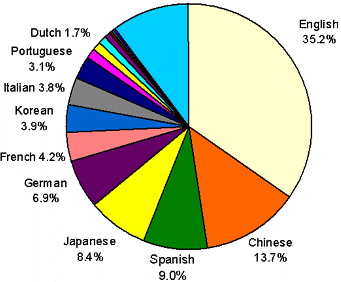
see also www.internetworldstats.com/stats.htm There is very slow growth in the number of internet users in North America and Europe and Australasia, some growth in Asia, with most growth coming from Latin America and Africa. |
from www.InternetWorldStats.com
© CopyrightMiniwatts International, Inc.
emails regarding permission
to quote/link can be found in WTGR's permissions binder
| Why
is India not on the list above?
Because the list is based on language spoken, not on nationality. There is no such language
as Indian ! - the main languages of India, are Hindi (spoken by 40%),
Bengali (8%), Telugu (8%), Marathi (7.5%), Tamil (6.3%) and
Urdu and Gujarati.
These languages of India are not statistically counted in the major internet language stats charts because each language is below the 20 million level in terms of Internet users. It is suggested by a number of sources that internet growth in India is maintaining a high percentage so at some time in the near future perhaps Hindi may be listed in the Top Ten Languages on the web. |
| Why
is Chinese on the list above?
Just like we said there is no such language as Indian, in reality, there is no such language as Chinese. It is just that Westerners
call it "Chinese" because most So when we see "spoken by Chinese" on a list, we have to guess that they mean the speakers of Mandarin in the PRC + the speakers of Cantonese in Hong Kong + the speakers of Mandarin in Taiwan. While Cantonese is spoken quite differently than Mandarin, all people who speak Cantonese can read Mandarin since the meaning of the Chinese alphabet characters is the same. |
| Government
information at the national level can be a helpful source of statistics
from which people may draw conclusions about the circumstances of e-commerce
in a country. The Canadian government has a particularly efficient agency
named "Statistics Canada" which tracks a variety of business and economic
indicators, including information on e-commerce.
see www.statcan.ca/Daily/English/050420/d050420b.htm WTGR |
| Value of Internet sales in Canada | |||||
|---|---|---|---|---|---|
| 2000 | 2001 | 2002 | 2003 | 2004 | |
| Private sector | |||||
| Public sector | |||||
| Total | |||||
| %'age increase
over the previous year |
00 to 01 = 14% | 01 to 02 = 70% | 02 to 03 = 68% | 03 to 04 = 45% | |
| From 2000 to
2001 sales increased slowly (14%) as companies began to go online.
From 2001 to 2002 there is a huge jump of 70% as more and more companies participate and each company becomes more effective at selling more online. The increase from 2002 to 2003 is strong again, but reaches only 68%. The increase from 2003 to 2004 has backed off to 45% suggesting (and this would be easier to confirm with 2005 figures) that the dot.com boom has peaked and that all of the companies who wanted to sell online, have done so by 2004. While Internet Sales have been remarkable for their quick rise on some product and service areas, overall, in terms of the total market for selling products and services, internet sales are still a very low percentage of total sales. Statscan said (in April 2005) that "...e-commerce still accounted for less than 1% of total operating revenue for private businesses" A 2007 survey of 19,000 Canadian businesses across various sectors found online sales generated an estimated $62.7 billion - this is still very small compared to the total amount of sales to consumers Permission to use this material from www.statcan.ca is according to the terms of use posted on their site (July 2005) at http://www.statcan.ca/english/reference/conditions.htm and www.itbusiness.ca/it/client/en/home/News.asp?id=48348&PageMem=1 |
| Canadian
shoppers VS. American
|
. | 2006 Canadian
online shoppers VS. U.S. online shoppers
According to a J.C. Williams Group www.jcwg.com study (discussed by reporter Dana Flavelle in the Toronto Star June 15th, 2006) Online sales account for
|
| Canadian
shoppers VS. American
|
. | Four possible
considerations for this scenario
1. shopping online is similar
to shopping from a mail order catalogue - a tradition that is well known
among American retailers of merchandise
2. Many Canadians buy from U.S. websites, which adds to the stats for U.S. websites sales, particular Amazon.com "back in the day" when the web was just beginning. Canadians did not buy from many Canadian sites for the simple reason that there were not many Canadian consumer product companies selling online 3. Many of the large consumer product companies in North America are American, with branches in Canada. Canadians easily buy millions of dollars worth of stuff each year from Home Depot, BUT, conversely, you do not have many Canadian consumer product companies retailing in the U.S. - for example you don't have Canadian Tire stores sprinkled through Texas the way they have Wal-Mart stores in Ontario. So if those many U.S. consumer products stores start selling thing on line, there will be Americans, and Canadians buying..The Bay and Future Shop do sell things online, but the volume they have available to satisfy a U.S. market is much less than an American company has for the Canadian market. 4. Payment. Despite new developments
in payment options, credit cards [2006] are still the preferred way of
paying for stuff bought on the web, and..... Americans, per capita, got
more credit cards than Canadians, and they have higher limits.
|
International
use of the Internet
 |
From the Globe
and Mail section www.globetechnology.com
"China has about 68 million Internet users among its 1.3 billion people, according to figures provided in July 2003 by the China Internet Network Information Center" xinhuanet.com reports China
having 111 million Internet users by the end of 2005
This statistic is significant because it suggests that China has more internet users than Japan (since Japan's total population is only 127 million) Statistics from the China Internet Network Information Center (CNNIC) show that 64 million Chinese netizens have broadband access to the Internet, up 50 % from 2004. One of the challenges that still plagues Chinese internet growth is the large number of people that still live in the rural areas, whereas most of Japan's population is urban.
|
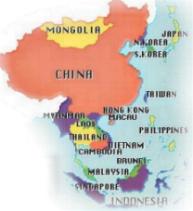 |
Asian use of
the Internet and e-commerce transactions effects Canada in two ways
1. Asians and Asian-Canadians living in Canada may have high expectations of the internet community in Canada - based on their high use in their respective home countries |
 |
From the ClickZ
section on Trends & Statistics www.clickz.com/stats/
"Online Asians Lead in Income, E-commerce Demographics" Story online by Robyn Greenspan, March 15, 2004 |
- original stats from www.themediaaudit.com |
Greenspan
begins his article by explaining one of the reasons Asians in the U.S.
may spend more money online is because they have more money to spend !
"While relatively low in numbers, the U.S. Asian population exhibits financial strength. Measured at just 4 percent of the Internet population, according to Jupiter Research (a unit of this site's corporate parent), 42 percent of Asian Internet households earn $75,000 or more annually, compared to 35 percent of Caucasians and 26 percent of African-Americans. " |
|||||||||||||||||||||
In Canada, in Toronto and Vancouver, the population of people online of Chinese, Japanese and Korean ethnicity is much higher (proportionately) than in the U.S., but we have not been able to find specific statistics to verify this."Nearly 31 percent of online Asians have made five or more Internet purchases in a year, and roughly 56 percent have made at least one purchase — overtaking the general Internet population and other online minorities... Asians as an ethnic group [in the United States] are making more purchases via the Internet than all of the other ethnic groups" |
Permission to quote given
by email in 2005 from Gus Venditto, Editor-in-Chief, Jupiterweb
| internet.com | ClickZ
| DevX | Earthweb |, Jupitermedia Corporation
Permission to quote given
by email in 2006 from Rebecca Lieb, Executive Editor
- copies of emails are kept
in the permissions binder
.
See this paper by Roger
Boshier & Yan Huang of UBC
www.edst.educ.ubc.ca/tern/Biblio/InternetUse.htm
which discusses the use
of the Internet among Chinese people in Vancouver
International use of the Internet: Asia; Japan

pop. 127 million |
Internet use in Japan in 2006 might be considered at the mature stage in the sense that Internet adoption was very early, compared to other countries in Asia, and Japanese electronics and IT companies flush with cash from the rise of the Yen in the 1990's, had lots of money for developing e-commerce related products and services in the early years of the web 1998-2003. |
| / | Some
of the things that makes internet use and e-commerce adoption different
in Japan compared to other Asian countries is
|
| , | For
one of the best sources on IT and e-commerce in Japan, access
www.terrie.com and www.japaninc.com This is the website of Terrie Lloyd, an Australian hi-tech entrepreneur who has lived in Japan for decades and made millions being in the right place at the right time for many of the dot.com circumstances that developed in the late 1990's and early Y2K. He is the founder of ComputingJapan Magazine and numerous other IT media enterprises.., and incredibly, he is also the owner of www.japan.com - talk about being "first off the post" (Prof. Richardson lived in Japan 1983-1985 and is a former executive director of the Canada-Japan Trade Council. In 1995-1998 he was the Canadian representative of Computing Japan magazine) |

pop. 48 million |
Internet use in South Korea exploded in the early years of Y2K because the large Korean construction companies that built apartment buildings in Seoul and the other large cities had the foresight to construct these buildings with fiber optic cable installed - therefore, allowing a large percentage of Korean citizens to have high speed access to the web. |
| . | One
of the consequences of several million people all having high speed access
to the web was that developers of web content felt encouraged to create
site with rich graphics and cool downloads which made it even more exciting
for young people to use the web.
"In December 2000, Korea succeeded in building a broadband Internet network covering 144 regions around the country two years ahead of schedule. As a result, broadband Internet access, scarcely available just a few years ago, is now being enjoyed by more than 8 million households, more than half of all households in the country. A total of 10,018 elementary, middle, and high schools around the country enjoy free broadband access." from the South Korean Ministry
of Commerce, Industry and Energy
|
pop. 1.1 billion
|
In the 1980's,
1990's and early Y2K, Canada has attracted, proportionate to our small
population, a large number of immigrants from India, Pakistan and Sri Lanka.
The reasons are varied, but include circumstances such as
It is suggested that the growth of the internet companies in Bangalore, and the very high percentage of internet use by young Canadians of Tamil, Indian and Pakistani background presents enormous opportunities for Canada to develop and expand e-business opportunities with South-Asia. |
| Madanmohan
Rao is quoted in 2004 as saying India has about 10 to 12 million Internet
users and 8 million cell phone users.* the CIA World Factbook states India
has about 50 million internet users by 2005. However the CIA does
not breakdown the 50 million into specific languages.
Delhi based AccessMedia said in 2001 that the Internet subscriber base in India will grow will grow at 60 % compounded growth over the next five years - a very impressive number. * The
reason for mentioning cell phone users in India is because it is through
cell phones that many people in India are accessing various internet based
services.
|
| Q3
2005
17.5 million urban Indians are using the Internet on a regular basis 5.2 million using it sparingly, "Total usage is around 23 million urban users at present - leaving Internet penetration in rural areas standing at 9% and the nationwide penetration a very low 2 %." A third of urban users are 'heavy users' using the Internet for more than three hours a day. "... to increase Internet penetration in India, two problems need to be solved. The first is of a more technical nature - relating to issues of speed and connectivity. The second, related to convincing Indian users that the Internet is useful beyond work hours. that is, they need to be converted from net users to net consumers." from the blog http://internetinasia.typepad.com/blog/2005/08/india_increase_.html |
| India's
population in perspective
1. the top 25% most intelligent
people in India is greater in number than the entire population of the
U.S.A.
|
|
|
CONTACT I MAIN PAGE I NEWS GALLERY I E-BIZ SHORTCUTS I INT'L BIZ SHORTCUTS I MKTG&BUSINESS SHORTCUTS I TEACHING SCHEDULE |
| . | |
| MISTAKES ITEXTS USED I IMAGES I RANK IDISCLAIMER I STUDENT CONTRIBUTORS I FORMER STUDENTS I | |
| . |